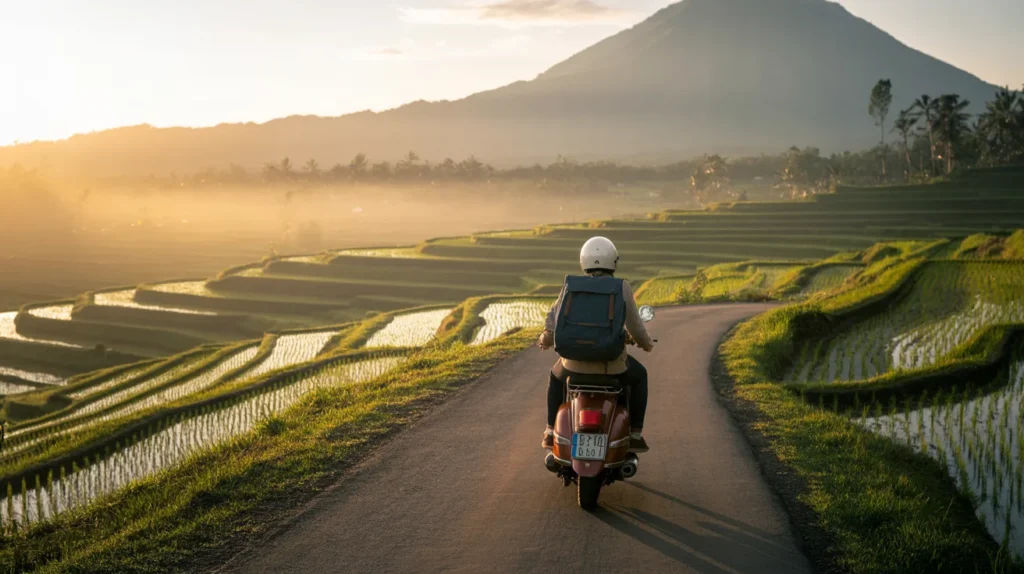There’s a version of Bali that lives in postcards — infinity pools, smoothie bowls, and sunsets that melt into cocktails. And then there’s the real Bali — the one whispered through jungle trails, carried in the scent of temple incense, and shared through laughter with strangers who quickly become friends.
If you want to feel that version—to know Bali instead of just visiting it—two weeks is all you need. Not the kind of trip where you tick off sights, but one where every day changes how you see the world.
Why Slow Travel Is the New Adventure
Somewhere between airport transfers and Instagram highlights, travel lost its breath. The best journeys aren’t about rushing from temple to beach — they’re about slowing down enough to notice the rhythm of life around you.
In Bali, that rhythm still beats strong. It’s in the farmers tending rice paddies before dawn, the motorbike hum weaving through Ubud’s backstreets, and the quiet smile of a shopkeeper handing you a cup of sweet coffee.
This two-week Bali backpacking itinerary is about more than movement — it’s about connection, both with the island and yourself.
Your 2-Week Local Backpacking Route
Days 1–3: Ubud — The Beating Heart of Bali
Start your journey in Ubud, where art, spirituality, and jungle air meet. Stay in a local homestay where your host leaves offerings at sunrise and greets you with coffee strong enough to wake the gods.
Skip the crowded Monkey Forest and explore lesser-known temples like Pura Gunung Kawi Sebatu. Wander the Tegalalang Rice Terraces early in the morning when mist still curls around the palms. Shop for handmade crafts in Ubud Market, but remember: it’s the conversation with the maker that matters, not the bargain.
By the end of your first few days, you’ll feel the island’s pulse settling into your own.

Days 4–6: Munduk & Amed — The Quiet North
Head north to Munduk, a mountain village wrapped in coffee plantations and cool mist. It’s the kind of place where time forgets to move. Chase waterfalls like Munduk, Banyumala, and Sekumpul, or simply sit with locals who’ll tell you stories about the spirits of the forest.
Then drift east to Amed, a sleepy fishing village where the sea replaces the mountains. Snorkel over the Japanese shipwreck, or float above coral gardens glowing like stained glass. At dawn, fishermen pull their boats ashore, their silhouettes framed by the rising sun — a sight that never loses its quiet magic.
Days 7–10: Nusa Penida & Gili Air — Island Life, Simplified
From Amed, catch a ferry to Nusa Penida — wild, rugged, and unpolished. Stand above Kelingking Beach, yes, but also drive to the calm north coast where children wave as you pass and women weave offerings by hand.
Afterward, sail toward Gili Air, a small island where cars don’t exist and time feels optional. You’ll get around by bicycle or barefoot. Days blend together — a snorkel here, a hammock there, a sunset you’ll swear was painted just for you.
In the evenings, fires flicker on the beach, and the line between locals and travelers blurs. This is what travel should feel like — community, not consumption.
Days 11–14: Canggu & Uluwatu — Surf, Soul, and Saltwater
Return to Bali’s mainland for your final stretch. Canggu is chaotic in the best way — where surfers, artists, and dreamers share the same Wi-Fi signal. Join a sunrise surf lesson, sip coconuts at local warungs, and let the rhythm of the ocean and music carry you through lazy afternoons.
End your trip in Uluwatu, where cliffs tumble into the sea and temples crown the horizon. Catch the Kecak dance at Uluwatu Temple, then linger for the afterglow — that orange moment when the island exhales.
Your final night in Bali isn’t about goodbye. It’s about gratitude — for the simplicity, the smiles, and the sense of belonging that lingers long after your flight home.

Cultural Notes: Travel With Heart
-
Dress with respect. Temples require shoulders and knees covered. Sarongs are easy to rent, but locals appreciate when you come prepared.
-
Learn the basics. “Terima kasih” (thank you) and “selamat pagi” (good morning) open doors faster than any app.
-
Choose community. Eat at warungs, not chain cafés. Every rupiah spent locally feeds a family.
Traveling like a local isn’t about pretending to be one — it’s about showing up with humility and curiosity.
Getting Around Without Stress
Bali’s roads are wild poetry — scooters zigzagging, horns that mean hello, and rules that bend to intuition.
-
Scooters are great for short distances (under $10/day). Always wear a helmet and drive defensively.
-
Shuttle vans connect major towns like Ubud, Canggu, and Amed cheaply.
-
Private drivers are worth the splurge for multi-stop days — expect around $40/day.
For island hops, fast boats run daily from Amed or Sanur to Nusa Penida and the Gilis. If waves look rough, wait it out. Bali rewards patience.
Where to Stay (and Feel at Home)
-
Ubud: Jawi House — family-run, full of warmth.
-
Munduk: Lesong Hotel — quiet mountain views and local meals.
-
Amed: Wawa Wewe II — sunset hammocks and ocean breeze.
-
Gili Air: Begadang — bamboo dorms under coconut palms.
-
Uluwatu: The Inn Possible — cliffs, surf, and soul.
Every place has its own heartbeat. The trick is to listen.

Products / Tools / Resources
-
🧭 Maps.me – Offline maps perfect for scooter adventures.
-
🏠 Hostelworld / Booking.com – For easy last-minute homestays.
-
🌿 Local Eco Tours (Bali Eco Stay, Green Village) – Sustainable travel done right.
Hopefully, this will give you some great itinerary ideas for your forthcoming trip. We have some other great information about Bali in this article: “Beyond the Resorts: The True Backpacker’s Guide to Surviving Bali on $30 a Day”.

